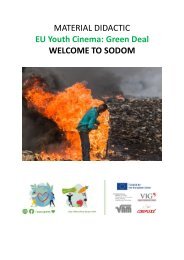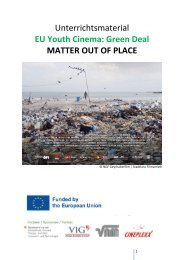LET'S CEE Film Festival Katalog 2017
Official Catalogue of the LET'S CEE Film Festival 2017
Official Catalogue of the LET'S CEE Film Festival 2017
You also want an ePaper? Increase the reach of your titles
YUMPU automatically turns print PDFs into web optimized ePapers that Google loves.
In almost every natural disaster – whether landslides, floods, typhoons or hurricanes – people<br />
have to flee their homes, sometimes even across national borders.<br />
Countries of origin and host countries overwhelmed by climate change impacts<br />
80% of refugees come from poor, crisis-ridden countries that are affected by climate change,<br />
but have few resources to prevent or mitigate its impacts. These include the five countries<br />
with the highest number of refugees worldwide: Syria, Venezuela, Afghanistan, South Sudan,<br />
and Myanmar. Most people forced to flee in the context of climate change and natural disasters<br />
remain in their own countries. 40% of the refugees live in countries that are particularly<br />
affected by climate change.<br />
Climate change harbors conflict potential<br />
Limited natural resources, such as drinking water, will become even scarcer in the future.<br />
Many crops and some livestock species will not be able to survive in certain areas if it becomes<br />
too hot and dry or too cold and wet. Food supply is already a concern in many regions of the<br />
world. People will have to try to adapt to this situation, but for many it will mean deliberately<br />
moving to another region to survive. The situation is also fueling a potential for conflict between<br />
communities as more and more people have to compete for fewer and fewer resources.<br />
Source:


















